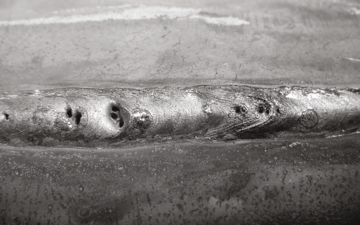Discover What is Porosity in Welding and Its Impact on Structural Honesty
Wiki Article
Recognizing Porosity in Welding: Checking Out Reasons, Results, and Avoidance Methods
As professionals in the welding market are well conscious, understanding the causes, impacts, and avoidance strategies related to porosity is important for accomplishing durable and reliable welds. By delving right into the origin causes of porosity, examining its destructive effects on weld top quality, and checking out reliable avoidance strategies, welders can improve their knowledge and skills to create high-grade welds consistently.Usual Reasons For Porosity
Contamination, in the form of dust, oil, or corrosion on the welding surface, creates gas pockets when heated, leading to porosity in the weld. Incorrect protecting occurs when the securing gas, commonly made use of in procedures like MIG and TIG welding, is not able to fully protect the molten weld pool from responding with the bordering air, resulting in gas entrapment and subsequent porosity. Furthermore, inadequate gas insurance coverage, frequently due to wrong circulation rates or nozzle positioning, can leave components of the weld unguarded, allowing porosity to create.Effects on Weld Top Quality
The visibility of porosity in a weld can considerably endanger the total top quality and honesty of the welded joint. Porosity within a weld develops gaps or tooth cavities that deteriorate the structure, making it extra prone to breaking, deterioration, and mechanical failing. These spaces act as anxiety concentrators, lowering the load-bearing capability of the weld and enhancing the probability of premature failing under applied stress and anxiety. In addition, porosity can likewise function as potential sites for hydrogen entrapment, further exacerbating the deterioration of the weld's mechanical properties.Additionally, porosity can impede the effectiveness of non-destructive screening (NDT) methods, making it testing to identify various other flaws or stoppages within the weld. This can cause substantial security worries, especially in important applications where the structural honesty of the bonded components is critical.

Prevention Techniques Summary
Offered the damaging influence of porosity on weld top quality, efficient prevention techniques are critical to keeping the architectural integrity of bonded joints. Among the primary avoidance methods is extensive cleansing of the base materials before welding. Impurities such as oil, grease, corrosion, and wetness can contribute to porosity, so ensuring a tidy work surface is vital. Proper storage space of welding consumables in dry conditions is likewise crucial to avoid dampness absorption, which can cause gas entrapment throughout welding. Additionally, choosing the suitable welding specifications, such as voltage, present, and travel speed, can help view publisher site lessen the threat of porosity development. Ensuring ample securing gas circulation and insurance coverage is another critical avoidance technique, as inadequate gas insurance coverage can cause climatic contamination and porosity. Appropriate welder training and accreditation are essential for executing precautionary procedures effectively and consistently. By incorporating these avoidance strategies right into welding techniques, the occurrence of porosity can be considerably decreased, bring about stronger and extra reliable bonded joints.Value of Appropriate Shielding
Correct protecting in welding plays an essential function in stopping climatic contamination and making sure the integrity of welded joints. Shielding gases, such as argon, helium, or a mixture of both, are typically made use of to protect the weld swimming pool from reacting with components airborne like oxygen and nitrogen. When these reactive elements enter contact with the hot weld pool, they can cause porosity, bring about weak welds with lowered mechanical residential properties.
Poor securing can lead to different defects like porosity, spatter, and oxidation, jeopardizing the structural integrity of the bonded joint. Sticking to correct protecting practices is necessary to produce top quality welds with marginal issues and guarantee the long life and reliability of the bonded parts.
Tracking and Control Methods
Just how can welders properly keep track of and regulate the welding procedure to make certain optimal outcomes and prevent problems like porosity? By continuously checking useful content these variables, welders can recognize discrepancies from the excellent problems and make prompt modifications to prevent porosity development.
Additionally, implementing appropriate training programs for welders is crucial for keeping track of and controlling the welding procedure properly. What is Porosity. Informing welders on the significance of preserving regular parameters, such as correct gas shielding and travel rate, can aid avoid porosity issues. Routine evaluations and qualifications can likewise ensure that welders excel in tracking and controlling welding procedures
Additionally, using automated welding systems can enhance tracking and control capabilities. These systems can precisely control welding criteria, decreasing the chance of human error and making sure constant weld high quality. By integrating advanced surveillance modern technologies, training programs, and automated systems, welders can efficiently keep an eye on and manage the welding process to minimize porosity defects and achieve high-quality welds.
Conclusion

Report this wiki page